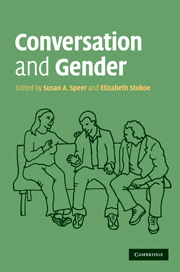Book contents
- Frontmatter
- Contents
- Contributors
- Data and transcription
- 1 An introduction to conversation and gender
- Part I Gender, person reference and self-categorization
- 2 The gendered ‘I’
- 3 Categories in talk-in-interaction: Gendering speaker and recipient
- 4 Doing gender categorization: Non-recognitional person reference and the omnirelevance of gender
- Part II Gender, repair and recipient design
- Part III Gender and action formation
- Part IV Gender identities and membership categorization practices
- References
- Author index
- Subject index
4 - Doing gender categorization: Non-recognitional person reference and the omnirelevance of gender
Published online by Cambridge University Press: 05 June 2012
- Frontmatter
- Contents
- Contributors
- Data and transcription
- 1 An introduction to conversation and gender
- Part I Gender, person reference and self-categorization
- 2 The gendered ‘I’
- 3 Categories in talk-in-interaction: Gendering speaker and recipient
- 4 Doing gender categorization: Non-recognitional person reference and the omnirelevance of gender
- Part II Gender, repair and recipient design
- Part III Gender and action formation
- Part IV Gender identities and membership categorization practices
- References
- Author index
- Subject index
Summary
Introduction
The questions of whether and how analysts of conversation should deal with the genders of conversational participants and whether and how conversation analytic methods can contribute to feminist research have recently been much debated (on gender: Billig, 1999; Schegloff, 1997; 1998a; 1999; Stokoe & Smithson, 2001; Wetherell, 1998; on feminism: Kitzinger, 2000a; Speer, 1999; 2005a). Ethnomethodologists and gender scholars have asserted that gender is ‘omnirelevant’ in interaction at least since Garfinkel's (1967: 118) classic study of ‘Agnes’ (see Weatherall, 2000; 2002b; West & Fenstermaker, 1995). Because the primary interest of conversation analysis has been to explicate the context-free organizations that enable interaction, conversation analysts have only more recently begun to address the context-specific ways in which gender is consequential for talk-in-interaction (see Jefferson, 2004a; Kitzinger, 2005a; 2005b; Land & Kitzinger, 2005). This chapter works to bridge the divide between gender theory and conversation analytic method by explicating how and why speakers do gender categorization in non-recognitional person reference. I explain why non-recognitional reference is a particularly important site for the classification of persons, and I argue that doing gender categorization at this site is normative. To understand how gender categorization comes to be ‘relevant’ in interaction, I introduce a distinction between action relevance – where a categorization is warranted by its ‘inference-rich’ (Sacks, 1992: 40) contribution to a speaker's meaning – and system relevance – where a categorization is warranted by the organization and interactional contingencies of person reference itself.
- Type
- Chapter
- Information
- Conversation and Gender , pp. 64 - 82Publisher: Cambridge University PressPrint publication year: 2011
- 5
- Cited by



